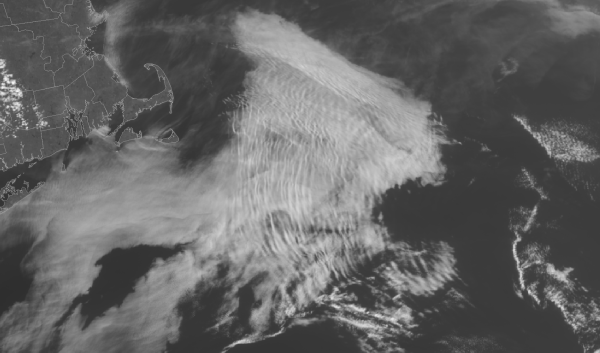NASA selects SSEC for Science Investigator-led Processing System (SIPS)

Suomi NPP VIIRS visible (0.65 µm) imagery of an atmospheric bore over New England on 8 May 2015. Credit: CIMSS.
NASA has contracted with the Space Science and Engineering Center (SSEC) at the University of Wisconsin-Madison to support its new Suomi National Polar-orbiting Partnership (SNPP) Science Team in the creation of a continuous Earth System Data Record (ESDR).
The initial contract will last four-and-a-half years, providing about $2 million per year. It is one of five NASA Suomi NPP Science Investigator-led Processing Systems (SIPS): the Visible Infrared Imaging Radiometer Suite (VIIRS) Atmosphere SIPS, based at SSEC; the VIIRS Land, VIIRS Ocean, and Ozone SIPS, located at NASA’s Goddard Space Flight Center; and the Sounder SIPS, located at NASA’s Jet Propulsion Laboratory.
Maintaining a continuous ESDR will provide scientists wishing to study long-term environmental issues, such as global climate change, with an uninterrupted archive of satellite data from the Suomi NPP mission.
“Researchers want to see a nice, unbroken record,” said SSEC scientist Liam Gumley, who is the principal investigator for the Atmosphere SIPS. “Our work will help researchers who are looking at the long-term variability of different parameters that could be impacted by climate change, such as global cloud cover.”
The primary task of the Atmosphere SIPS, led by Gumley and co-investigators Steve Ackerman and Bob Holz, is to create atmosphere products from the VIIRS instrument onboard the SNPP satellite, using algorithms and software created by the NASA SNPP Science Team.
NASA Goddard Space Flight Center sends the raw satellite data to SSEC, where the Atmosphere SIPS team processes them to create global atmospheric products — such as cloud height, cloud phase, cloud properties, and aerosol optical thickness — which they then send back to NASA, with metadata, for archiving and distribution.
“Our role is mainly to be the production engine,” said Gumley. “We process all the global atmospheric data from Suomi NPP: daytime, nighttime, from pole to pole, every day.”
The group processes data in what is called a “forward stream,” explained Gumley, processing “today’s data today, and tomorrow’s data tomorrow.”
Assessment is another key component of their work. While processing the Suomi NPP data, Atmosphere SIPS scientists are able to provide immediate feedback to help develop and test the Science Team’s algorithms and software, demonstrate that they are working properly, and eventually transition them into production.
In the future, said Gumley, the Atmosphere SIPS will also be responsible for reprocessing those data. Reprocessing allows consistent and up-to-date products to be created for the whole SNPP mission, which is important for decades-long climate studies.
“When the Science Team says they’re ready,” he said, “we will reprocess all data from the Suomi NPP mission, dating all the way back to January 2012.”
The group plans to get started on that next step in 2016, said Gumley, when the SNPP Science Team completes its algorithm development and testing, and delivers the production-ready software to SSEC.
“For the reprocessing, NASA wants to see a turnaround time of a matter of weeks,” said Gumley. “In the past, for atmospheric products, Science Teams have had to wait months and even years — so this will be a fairly significant achievement.”
SSEC has been guaranteed this role for as long as the Suomi NPP mission is in orbit – and then some.
“NASA has said it will keep us around for three years after the SNPP mission ends, so the Science Team can finish its algorithm testing and product validation,” said Gumley.
It is also expected that the Atmosphere SIPS would continue to be involved with forthcoming missions, such as the Joint Polar Satellite System JPSS-1 and JPSS-2 satellites.
SSEC has a long history of involvement with this project, one that predates the launch of the Suomi NPP satellite. The forerunner to SIPS, the NPP Product and Evaluation and Test Elements (PEATE) program, was established in 2007. Similar to the SIPS effort, it was divided into five components — Atmosphere, Land, Ocean, Ozone and Sounder — with the Atmosphere PEATE located at SSEC, and led by SSEC director Hank Revercomb and Gumley, who described the transition from one program to another as “seamless.”
In their work through the Atmosphere PEATE, Gumley recalled, SSEC scientists developed back-end expertise and a variety of tools that are now proving useful for Atmosphere SIPS. These included batch processing systems to process data quickly and efficiently, search-and-order mechanisms that enable users to easily discover and download data, and a collocation system that allows users to compare two datasets from two different satellites, helping scientists validate their products.
The Atmosphere SIPS is also reaping the benefits of strong working relationships forged with members of the Science Team during the PEATE era, some of which have carried over to the current team. That tradition of open communication persists to this day.
“For every person on the Science Team, we have a dedicated person here at SSEC to serve as their point-of-contact with the Atmosphere SIPS,” explained Gumley.
As a non-NASA facility, SSEC is unique among the three organizations awarded a SIPS contract.
“It is notable that NASA is willing to trust us with such an important project not on their soil,” said Gumley. “I think it says something about SSEC’s capabilities — in science, algorithm testing, and building efficient processing systems.”
by Sarah Witman
